Hull J.C. Risk management and Financial institutions
Подождите немного. Документ загружается.

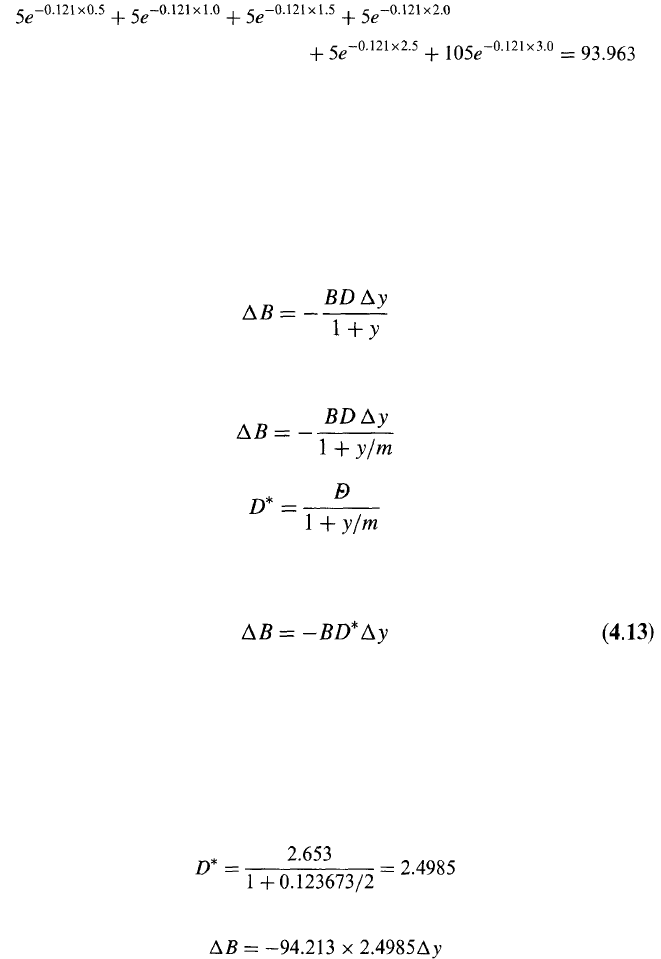
92
Chapter 4
so that the bond price goes down to 94.213 — 0.250 = 93.963. How accurate is
this? When the bond yield increases by 10 basis points to 12.1%, the bond
price is
which is (to three decimal places) the same as that predicted by the duration
relationship.
Modified Duration
The preceding analysis is based on the assumption that y is expressed with
continuous compounding. If y is expressed with annual compounding, it
can be shown that the approximate relationship in equation (4.11)
becomes
More generally, if y is expressed with a compounding frequency of m
times per year, then
A variable D* defined by
is sometimes referred to as the bond's modified duration. It allows the
duration relationship to be simplified to
when y is expressed with a compounding frequency of m times per year.
The following example investigates the accuracy of the modified duration
relationship.
Example 4.6
The bond in Table 4.5 has a price of 94.213 and a duration of 2.653. The yield,
expressed with semiannual compounding is 12.3673%. The modified duration
D*
is
From equation (4.13), we have
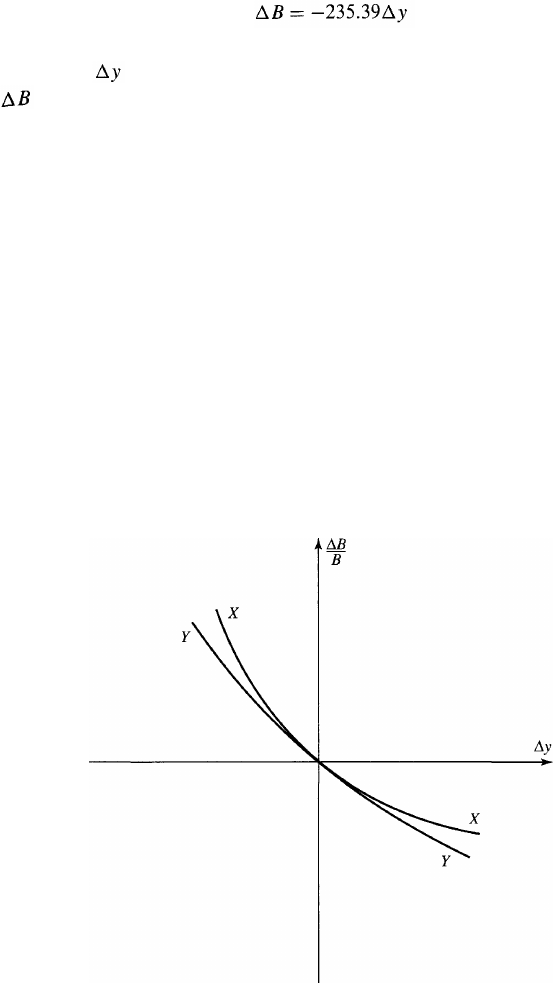
Interest Rate Risk
93
or
When the yield (semiannually compounded) increases by 10 basis points
(=0.1%), =+0.001. The duration relationship predicts that we expect
to be —235.39 x 0.001 = —0.235, so that the bond price goes down to
94.213 - 0.235 = 93.978. How accurate is this? When the bond yield (semi-
annually compounded) increases by 10 basis points to 12.4673% (or to
12.0941% with continuous compounding), an exact calculation similar to that
in the previous example shows that the bond price becomes 93.978. This shows
that the modified duration calculation is accurate for small yield changes.
4.6 CONVEXITY
The duration relationship measures exposure to small changes in yields.
This is illustrated in Figure 4.2, which shows the relationship between the
percentage change in value and change in yield for bonds having the same
duration. The gradients of the two curves are the same at the origin. This
means that both portfolios change in value by the same percentage for
small yield changes, as predicted by equation (4.12). For large yield
Figure 4.2 Two portfolios with the same duration.
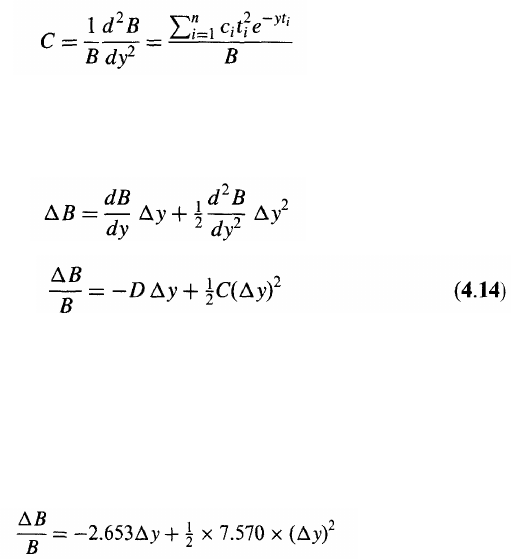
94 Chapter 4
changes, the portfolios behave differently. Portfolio X has more curvature
in its relationship with yields than Portfolio Y. A factor known as
convexity measures this curvature and can be used to improve the
relationship in equation (4.12).
A measure of convexity for a bond is
where y is the bond's yield. This is the weighted average of the square of
the time to the receipt of cash flows. From Taylor series expansions, a
more accurate expression than equation (4.9) is
This leads to
Example 4.7
Consider again the bond in Table 4.5: the bond price B is 94.213 and the
duration D is 2.653. The convexity is
0.05 x 0.5
2
+ 0.047 x 1.0
2
+ 0.044 x 1.5
2
+ 0.042 x 2.0
2
+ 0.039 x 2.5
2
+ 0.779 x 3.0
2
= 7.570
The convexity relationship in equation (4.14) is therefore
Consider a 2% change in the bond yield from 12% to 14%. The duration
relationship predicts that the dollar change in the value of the bond will be
—94.213 x 2.653 x 0.02 = —4.999. The convexity relationship predicts that it
will be
-94.213 x 2.653 x 0.02 + 0.5 x 94.213 x 7.570 x 0.02
2
= -4.856
The actual change in the value of the bond is —4.859. This shows that the
convexity relationship gives much more accurate results than duration for a
large change in the bond yield.
4.7 APPLICATION TO PORTFOLIOS
The duration concept can be used for any portfolio of assets dependent
on interest rates. Suppose that P is the value of the portfolio. We make a
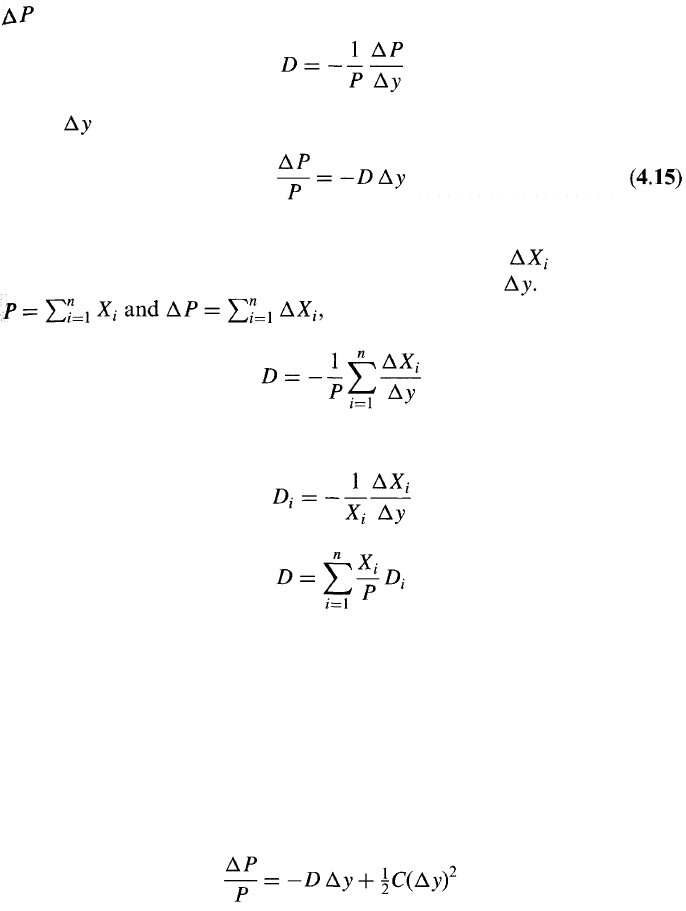
Interest Rate Risk
95
small parallel shift in the zero-coupon yield curve and observe the change
in P. Duration is defined as
where is size of the parallel shift. Equation (4.12) becomes
Suppose the portfolio consists of a number of assets. The ith asset is
worth X
i
and has a duration D
i
(i = 1,..., n). Define as the change
in the value of X
i
arising from the yield curve shift It follows that
so that the duration of the portfolio is
given by
The duration of the ith asset is
Hence,
This shows that the duration D of a portfolio is the weighted average of
the durations of the individual assets comprising the portfolio with the
weight assigned to an asset being proportional to the value of the asset.
The convexity can be generalized in the same way as the duration. For
an interest-rate-dependent portfolio with value P, we define the convexity
as 1/P times the second partial derivative of the value of the portfolio
with respect to a parallel shift in the zero-coupon yield curve. Equation
(4.14) is correct with B replaced by P:
(4.16)
The relationship between the convexity of a portfolio and the convexity of
the assets comprising the portfolio is similar to that for duration: the
convexity of the portfolio is the weighted average of the convexities of the
assets with the weights being proportional to the value of the assets.
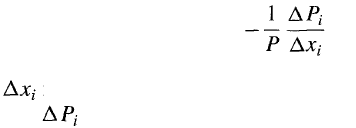
96 Chapter 4
The convexity of a bond portfolio tends to be greatest when the
portfolio provides payments evenly over a long period of time. It is least
when the payments are concentrated around one particular point in time.
Portfolio Immunization
A portfolio consisting of long and short positions in interest-rate-
dependent assets can be protected against relatively small parallel shifts
in the yield curve by ensuring that its duration is zero. It can be
protected against relatively large parallel shifts in the yield curve by
ensuring that its duration and convexity are both zero or close to zero.
In this respect duration and convexity are analogous to the delta and
gamma Greek letters we encountered in Chapter 3.
4.8 NONPARALLEL YIELD CURVE SHIFTS
Unfortunately, the basic duration relationship in equation (4.15) only
quantifies exposure to parallel yield curve shifts. The duration plus
convexity relationship in equation (4.16) allows the shift to be relatively
large, but it is still a parallel shift.
Some researchers have attempted to extend duration measures so that
nonparallel shifts can be considered. Reitano suggests a partial duration
measure where just one point on the zero-coupon yield curve is shifted
and all other points remain the same.
7
Suppose that the zero curve is as
shown in Table 4.6 and Figure 4.3. Shifting the five-year point involves
changing the zero curve as indicated in Figure 4.4. In general, the partial
duration of the portfolio for the ith point on the zero curve is
where is the size of the small change made to the ith point on the yield
curve and is the resultant change in the portfolio value. The sum of
all the partial duration measures equals the usual duration measure.
Suppose that the partial durations for a particular portfolio are as
shown in Table 4.7. The total duration of the portfolio is only 0.2. This
means that the portfolio is relatively insensitive to parallel shifts in the
yield curve. However, the durations for short maturities are positive while
7
See R. Reitano, "Non-Parallel Yield Curve Shifts and Immunization," Journal of
Portfolio Management, Spring 1992, 36-43.
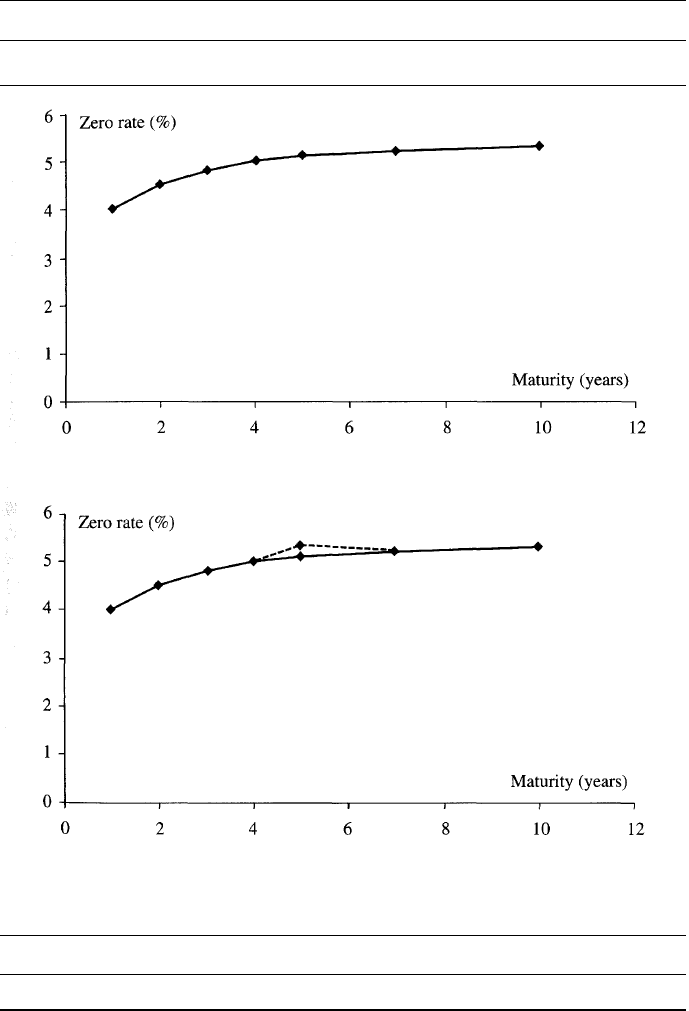
Interest Rate Risk 97
Table 4.6 Zero-coupon yield curve (rates continuously compounded).
Maturity (years)
Rate (%)
1
4.0
2
4.5
3
4.8
4
5.0
5
5.1
7
5.2
10
5.3
Figure 4.3 The zero-coupon yield curve in Table 4.6.
Figure 4.4 Change in zero-coupon yield curve when one point is shifted.
Table 4.7 Partial durations for a portfolio.
Maturity (years)
Duration
1
2.0
2
1.6
3
0.6
4
0.2
5
-0.5
7
-1.8
10
-1.9
Total
0.2
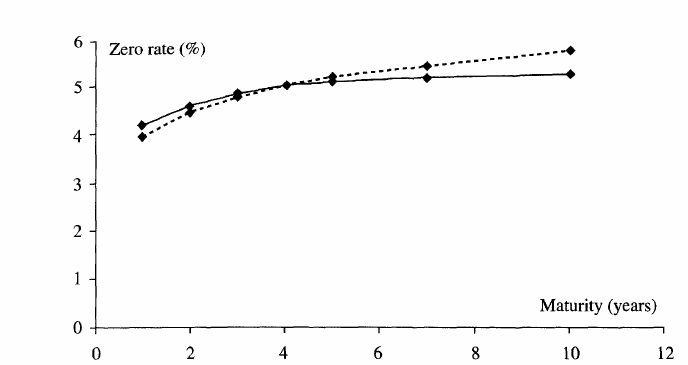
98 Chapter 4
Figure 4.5 A rotation of the yield curve.
those for long maturities are negative. This means that the portfolio loses
(gains) in value when short rates rise (fall). It gains (loses) in value when
long rates rise (fall).
We are now in a position to go one step further and calculate the
impact of nonparallel shifts. We can define any type of shift we want.
Suppose that, in the case of the yield curve shown in Figure 4.3, we define
a rotation where the changes to the 1-year, 2-year, 3-year, 4-year, 5-year,
7-year, and 10-year points are — 3e, —2e, —e, 0, e, 3e, and 6e for some
small e. This is illustrated in Figure 4.5. From the partial durations in
Table 4.7, the percentage change in the value of the portfolio arising from
the rotation is
2.0 x (-3e) + 1.6 x (-2e) + 0.6 x (-e) + 0.2 x 0
- 0.5 x e - 1.8 x 3e - 1.9 x 6e = -27.1e
This shows that a portfolio that gives rise to the partial durations in Table
4.7 is much more heavily exposed to a rotation of the yield curve than to a
parallel shift.
4.9 INTEREST RATE DELTAS
We now move on to consider how the Greek letters discussed in Chapter 3
can be calculated for interest rates. One possibility is to define the delta of
a portfolio as the change in value for a one-basis-point parallel shift in
the zero curve. This is sometimes termed a DV01. It is the same as the
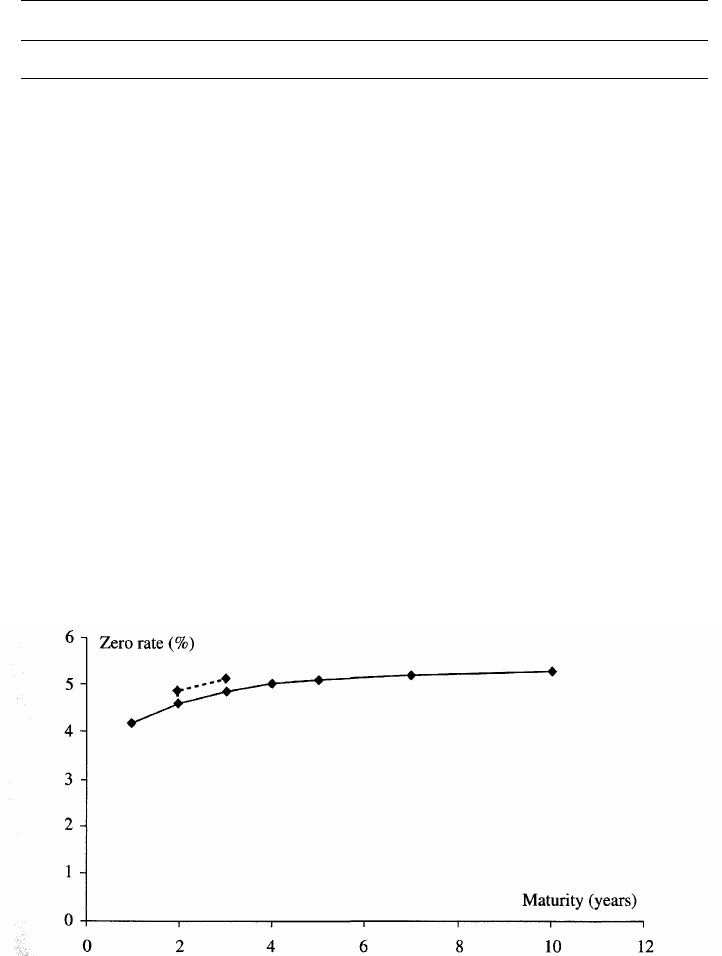
Interest Rate Risk 99
Table 4.8 Deltas for portfolio in Table 4.7. Value of Portfolio is $1 million.
The dollar impact of a one-basis-point shift in points on the zero curve is shown.
Maturity (years)
Delta
1
200
2
160
3
60
4
20
5
-50
7
-180
10
-190
Total
20
duration of the portfolio multiplied by the value of the portfolio multi-
plied by 0.0001.
In practice, analysts like to calculate several deltas to reflect their
exposures to all the different ways in which the yield curve can move.
There are a number of different ways this can be done. One approach
corresponds to the partial duration approach that we outlined in the
previous section. It involves computing the impact of a one-basis-point
change similar to the one illustrated in Figure 4.4 for each point on the
zero-coupon yield curve. This delta is the partial duration calculated in
Table 4.7 multiplied by the value of the portfolio multiplied by 0.0001.
The sum of the deltas for all the points on the yield curve equals the
DV01. Suppose that the portfolio in Table 4.7 is worth $1 million. The
deltas are shown in Table 4.8.
A variation on this approach is to divide the yield curve into a number
of segments or "buckets" and calculate for each bucket the impact of
changing all the zero rates corresponding to the bucket by one basis
point while keeping all other zero rates unchanged. This approach is
often used in asset-liability management (see Section 1.5) and is referred
to as GAP management. Figure 4.6 shows the type of change that would
Figure 4.6 Change considered to yield curve when bucketing approach is used.
100
Chapter 4
be considered for the segment of the zero curve between 2.0 and 3.0 years
in Figure 4.3. Again, the sum of the deltas for all the segments equals
the DV01.
Calculating Deltas to Facilitate Hedging
One of the problems with the delta measures that we have considered so
far is that they are not designed to make hedging easy. Consider the deltas
in Table 4.8. If we plan to hedge our portfolio with zero-coupon bonds,
we can calculate the position in a one-year zero-coupon bond to zero out
the $200 per basis point exposure to the one-year rate, the position in a
two-year zero-coupon bond to zero out the exposure to the two-year rate,
and so on. But, if other instruments are used, a much more complicated
analysis is necessary.
In practice, traders tend to use positions in the instruments that have
been used to construct the zero curve to hedge their exposure. For
example, a government bond trader is likely to take positions in the
actively traded government bonds that were used to construct the Treas-
ury zero curve when hedging. A trader of instruments dependent on the
LIBOR/swap yield curve is likely to take positions in LIBOR deposits,
Eurodollar futures, and swaps when hedging.
To facilitate hedging, traders therefore often calculate the impact of
small changes in the quotes for each of the instruments used to construct
the zero curve. Consider a trader responsible for interest rate caps and
swap options. Suppose that the trader's exposure to a one-basis-point
change in a Eurodollar futures quote is $500. Each Eurodollar futures
contract changes in value by $25 for a one-basis-point change in the
Eurodollar futures quote. It follows that the trader's exposure can be
hedged with 20 contracts. Suppose that the exposure to a one-basis-point
change in the five-year swap rate is $4,000 and that a five-year swap with a
notional principal of $ 1 million changes in value by $400 for a one-basis-
point change in the five-year swap rate. The exposure can be hedged by
trading swaps with a notional principal of $10 million.
4.10 PRINCIPAL COMPONENTS ANALYSIS
The approaches we have just outlined can lead to analysts calculating
10 to 15 different deltas for every zero curve. This seems like overkill
because the variables being considered are quite highly correlated with
each other. For example, when the yield on a five-year bond moves up by

Interest Rate Risk
101
Table 4.9 Factor loadings for US Treasury data.
3m
6m
12m
2y
3y
4y
5y
7y
10y
30y
PC1
0.21
0.26
0.32
0.35
0.36
0.36
0.36
0.34
0.31
0.25
PC2
-0.57
-0.49
-0.32
-0.10
0.02
0.14
0.17
0.27
0.30
0.33
PC3
0.50
0.23
-0.37
-0.38
-0.30
-0.12
-0.04
0.15
0.28
0.46
PC4
0.47
-0.37
-0.58
0.17
0.27
0.25
0.14
0.01
-0.10
-0.34
PC5
-0.39
0.70
-0.52
0.04
0.07
0.16
0.08
0.00
-0.06
-0.18
PC6
-0.02
0.01
-0.23
0.59
0.24
-0.63
-0.10
-0.12
0.01
0.33
PC7
0.01
-0.04
-0.04
0.56
-0.79
0.15
0.09
0.13
0.03
-0.09
PC8
0.00
-0.02
-0.05
0.12
0.00
0.55
-0.26
-0.54
-0.23
0.52
PC9
0.01
-0.01
0.00
-0.12
-0.09
-0.14
0.71
0.00
-0.63
0.26
PC10
0.00
0.00
0.01
-0.05
-0.00
-0.08
0.48
-0.68
0.52
-0.13
a few basis points, most of the time the yield on a ten-year bond does the
same. Arguably a trader should not be worried when a portfolio has a
large positive exposure to the five-year rate and a similar large negative
exposure to the ten-year rate.
One approach to handling the risk arising from groups of highly
correlated market variables is principal components analysis. This takes
historical data on movements in the market variables and attempts to
define a set of components or factors that explain the movements.
The approach is best illustrated with an example. The market variables
we will consider are ten US Treasury rates with maturities between three
months and 30 years. Tables 4.9 and 4.10 show results produced by Frye
for these market variables using 1,543 daily observations between 1989
and 1995.
8
The first column in Table 4.9 shows the maturities of the rates
that were considered. The remaining ten columns in the table show the
ten factors (or principal components) describing the rate moves. The first
factor, shown in the column labeled PC1, corresponds to a roughly
parallel shift in the yield curve. When we have one unit of that factor,
Table 4.10 Standard deviation of factor scores (basis points).
8
See J. Frye, "Principals of Risk: Finding VAR through Factor-Based Interest Rate
Scenarios." In VAR: Understanding and Applying Value at Risk, Risk Publications,
London, 1997, pp. 275-288.
PCI
17.49
PC2 PC3 PC4 PC5 PC6 PC7 PC8 PC9
6.05 3.10 2.17 1.97 1.69 1.27 1.24 0.80
PC10
0.79
